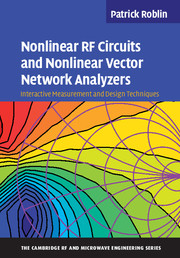 Nonlinear RF Circuits and Nonlinear Vector Network Analyzers
Nonlinear RF Circuits and Nonlinear Vector Network Analyzers Book contents
- Frontmatter
- Contents
- Preface
- Dedication
- Acknowledgments
- 1 Wireless signals
- 2 Large-signal vector measurement techniques with NVNAs
- 3 Device modeling and verification with NVNA measurements
- 4 Characterization and modeling of memory effects in RF power transistors
- 5 Interactive loadline-based design of RF power amplifiers
- 6 Behavioral modeling
- 7 Kurokawa theory of oscillator design and phase-noise theory
- 8 Design, modeling, and linearization of mixers, modulators, and demodulators
- 9 Linearization of RF power amplifiers with memory
- Index
- References
3 - Device modeling and verification with NVNA measurements
Published online by Cambridge University Press: 05 July 2011
- Frontmatter
- Contents
- Preface
- Dedication
- Acknowledgments
- 1 Wireless signals
- 2 Large-signal vector measurement techniques with NVNAs
- 3 Device modeling and verification with NVNA measurements
- 4 Characterization and modeling of memory effects in RF power transistors
- 5 Interactive loadline-based design of RF power amplifiers
- 6 Behavioral modeling
- 7 Kurokawa theory of oscillator design and phase-noise theory
- 8 Design, modeling, and linearization of mixers, modulators, and demodulators
- 9 Linearization of RF power amplifiers with memory
- Index
- References
Summary
Compact models of active devices that are integrated into circuit simulators are an integral part of the design process of both RF integrated circuits (RFICs) and monolithic microwave integrated circuits (MMICs). The accuracy of these device models in capturing the range of behavior of the devices is of critical importance for the successful design of first-pass RFICs and MMICs. Reliable compact device models have also come to be expected by microwave engineers for the design of RF/microwave circuits using discrete components such as power amplifiers, mixers, and oscillators.
This chapter will present some examples of the applications of NVNA measurements to both device modeling and model verification. The focus will be placed on devices for which memory effects are not dominant. The characterization and modeling of memory effects will be discussed in the next chapter.
NVNAs are primarily used for model verification, and an example will be presented. Various RF excitations can be used to test the devices in normal mode of operation, in breakdown [1] [2], or to investigate the device symmetry or lack thereof. Finally, using even more exotic modulated excitations, NVNA measurements can permit one to rapidly capture, in a single measurement, the operation of the device in a wide range of voltages for the direct extraction of nonlinear models.
- Type
- Chapter
- Information
- Nonlinear RF Circuits and Nonlinear Vector Network AnalyzersInteractive Measurement and Design Techniques, pp. 66 - 88Publisher: Cambridge University PressPrint publication year: 2011


